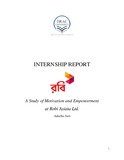A Study of motivation and empowerment at Robi Axiata Ltd.
Abstract
This report is a reflection of the learning and experiences acquired through an opportunity to be associated with Robi Axiata Ltd. for an internship under the Market Operations department. This department is made up of many sub-departments; however, this report focuses on the ones that were closely observed. The three main sub-departments were the Dhonnobad Program, Campaign and International Roaming. The major responsibilities associated with this particular job title comprised of working on partnership management (managing contracts and promotions), managing events, data analysis and interpretation for high value customers and creating reports on the progress of the different aspects of the Dhonnobad Program.
The report goes on to discuss the different aspects of job performance. The nature of measuring job performance is mainly dependent on the fast paced service orientation culture of the industry. Therefore, making the performance criterion to be demanding at all stages. Targets, one’s ability to cope with team work, the ability to efficiently and effectively identify consumer needs in the highly variable technological environment. There were clear indications for room for improvement on the daily activities of the department and its employees, thus critical observations and recommendations regarding resource management, setting targets, cooperation with the IT team, taking ownership of work, bridging communication gaps and improving extrinsic satisfaction is just a few of the suggested improvements.
The main project is a study carried out with three departments of Robi Axiata Ltd. It is a study on the relationship between extrinsic and intrinsic factors existing in the organization. A sample of 30 was taken to carry out primary research. Through the use of a survey data collection was executed. The analysis of the data has been done through statistical tools such as the SPSS. Some selective factors were chosen from the list of the survey conducted on the three departments as all of them were not appropriate for this study. The original supposition was that intrinsic and extrinsic factors have a strong positive relationship. However, the opposite has been proven for this case. The data analysis and interpretation has been based on results from the calculation of mean, standard deviation, variance and correlation. Recommendations have been made on the results suggested through statistical evidence. It must be said that the sample size may not provide clear representation of the actual circumstances.

